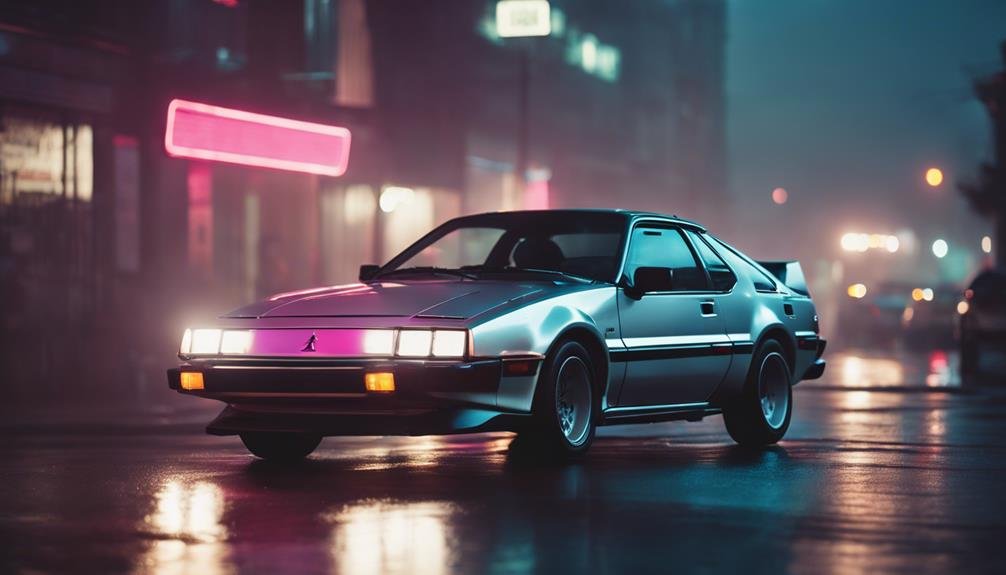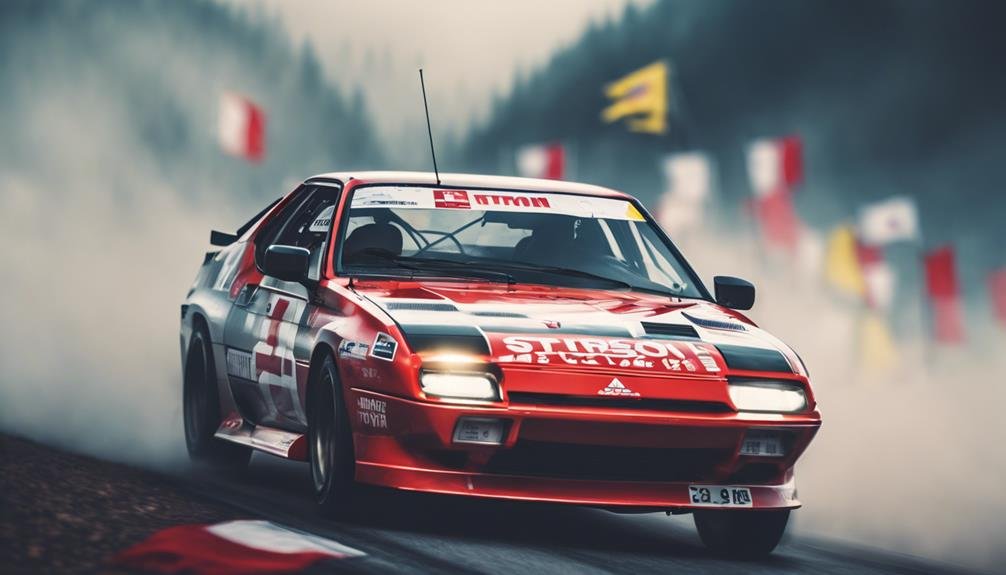The Mitsubishi Starion, a sports car produced from 1982 to 1990, has been quietly gaining attention among car enthusiasts and collectors. Its sleek design, luxurious amenities, and impressive performance capabilities make it a hidden gem. As rare models resurface and enthusiasts uncover its rich history, the Starion's value and appeal continue to appreciate. But what secrets lie beneath its sleek exterior? What set it apart from its contemporaries, and what makes it a sought-after collector's item today?
Unveiling the Mitsubishi Starion

As the curtains of obscurity lift, the Mitsubishi Starion emerges as a captivating enigma, its mystique fueled by its relative rarity and understated presence in the pantheon of iconic Japanese sports cars.
Introduced in 1982, this classic sports car was named after the mythical horse, Arion. The Starion set the standard for future iconic Mitsubishi cars, inspiring many Japanese sports cars that followed.
Despite its unique appeal, it remains a rare sight on the road, particularly in the U.S. and Europe, where it was marketed differently. This air of mystery has contributed to its allure, making it a sought-after collector's item.
With its rich history and understated presence, the Starion is an intriguing subject worthy of exploration.
Design Elements and Features
The Mitsubishi Starion's design elements and features, both inside and out, played a significant role in setting it apart from its contemporaries. Its futuristic aesthetic and trailblazing amenities made it a standout among 1980s sports cars. The Starion's exterior boasts classic pop-up headlights, four-wheel disk brakes, and a sleek, aerodynamic design.
Inside, amenities like cruise control, power windows, and a digital clock create a luxurious atmosphere. The leather seats add a touch of sophistication, while the fully electronic seat belts provide a sense of safety. These inventive features, combined with its turbocharged engine, make the Starion a true pioneer of its time.
Performance and Model Variations

Several configurations of the Mitsubishi Starion were offered, each catering to distinct performance preferences and regional markets. The narrowbody and widebody models differed in turbocharged power outputs, with the latter featuring intercoolers for improved performance.
The ESI-R widebody model boasted increased power, while the Turbo model was built for aggressive driving, with tunable engines capable of over 300hp. Standard features on the Turbo included limited slip differentials, anti-locking brakes, and MacPherson strut suspension.
These variations allowed buyers to choose the perfect Starion to suit their driving style and preferences. With such a range of options, it's no wonder the Starion remains a sought-after collectible among car enthusiasts.
Engine Options and Upgrades
Powerplant permutations played a pivotal role in the Mitsubishi Starion's performance profile. Most markets received the SOHC 2.0 L Sirius G63B engine, while North American models were equipped with the SOHC Astron G54B 2.6L inline-four engine, both turbocharged with electronic fuel injection. These powerplants delivered horsepower ranging from 150 to 195, mated to either a 5-speed manual or 4-speed automatic transmission.
A Sports Handling Package, available on later U.S. models, further improved performance with adjustable front and rear struts, wider wheels, and programmable computers for individual fuel injectors. This package also included upgraded 5-lug hubs, allowing owners to fine-tune their Starion for best performance.
With these engine options and upgrades, the Mitsubishi Starion offered a compelling blend of power and handling.
Motorsport Achievements and Legacy

Racing circuits around the world witnessed the Mitsubishi Starion's competitive prowess, as it vigorously competed in diverse motorsport events, including the Japan Touring Car Race and World Rally Championships.
The Starion's impressive performance earned it three SCCA U.S. endurance championships, solidifying its reputation as a formidable contender. Its turbocharged engine and advanced suspension system allowed it to excel in assorted racing conditions.
The Starion's motorsport achievements have had a lasting impact on the U.S. racing scene, making it a revered name among enthusiasts. Today, its legacy continues to inspire, with many car collectors seeking out this high-performance vehicle.
Rarity and Collector's Appeal
The Mitsubishi Starion's relative obscurity in the collector's market, compared to other iconic Japanese sports cars, has contributed to its allure, making it a coveted find among enthusiasts.
Its rarity is partly due to its limited production run and lack of widespread marketing, resulting in a scarcity that fuels its desirability.
The Starion's unique design, turbocharged engine, and advanced features for its time have captivated collectors seeking a distinctive and affordable asset to their garages.
As a result, the Starion has become a hidden gem, prized by those in the know for its blend of performance, style, and exclusivity.
Its relative affordability compared to other Japanese sports cars from the 1980s only adds to its appeal, making it a sought-after find among collectors.
Reviving Interest and Future Value

As collector interest in 1980s Japanese sports cars continues to surge, the Mitsubishi Starion's unique blend of performance, style, and exclusivity positions it for a significant appreciation in value over time. This rare and underappreciated gem is poised to regain its rightful place among iconic Japanese sports cars.
Several factors contribute to its potential value increase:
- Rarity: With limited production numbers, the Starion is a rare find, making it highly sought after by collectors.
- Performance: Its turbocharged engine and sport-tuned suspension make it a thrill to drive, appealing to enthusiasts.
- Exclusivity: As a lesser-known model, the Starion offers a unique ownership experience, setting it apart from more popular Japanese sports cars.
As interest in 80s Japanese sports cars continues to grow, the Starion is likely to appreciate in value, making it a smart investment for collectors.
Frequently Asked Questions
What Are the Most Common Colors for the Mitsubishi Starion?
The Mitsubishi Starion's most common colors include Arctic Silver, Caspian Blue, and Graphite Gray, which were popular during the 1980s and still sought after by collectors today, adding to the car's nostalgic appeal.
How Does the Starion's Turbocharger Impact Fuel Efficiency?
The Mitsubishi Starion's turbocharger, while improving performance, compromises fuel efficiency, with estimates suggesting a 10-15% decrease in mileage compared to naturally aspirated engines, due to increased pressure and air density.
Are There Any Known Issues With the Starion's Electronic Seat Belts?
Regarding the electronic seat belts, owners have reported occasional malfunctioning, such as faulty sensors or stuck buckles, which can be resolved through routine maintenance and replacement of worn-out components, ensuring maximum safety features.
Can the Starion's Digital Clock Be Replaced With a Modern Unit?
Replacing the Starion's digital clock with a modern unit is feasible, but requires careful consideration of compatibility, wiring, and aesthetics to maintain the vehicle's original character while integrating contemporary technology.
Are There Any Aftermarket Support or Parts Available for the Starion?
Aftermarket support for the Mitsubishi Starion is limited, but enthusiasts can find specialized suppliers offering performance upgrades, including turbochargers and suspension components, along with rare replacement parts for restoration projects.
